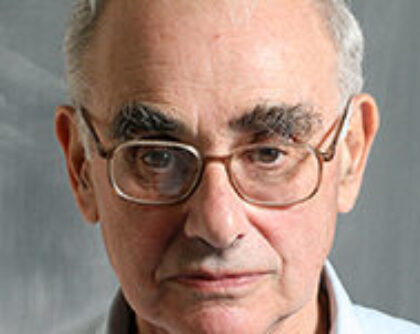Jeffrey Goldstone
Research Interests
Algorithms for quantum computers.
Biographical Sketch
Professor Jeffrey Goldstone received his education at Cambridge University (B.A. 1954, Ph.D. 1958). He worked on the theory of nuclear matter under the guidance of Hans Bethe and developed the use of Feynman diagrams for non-relativistic many-fermion systems.
Goldstone was a research fellow of Trinity College, Cambridge, from 1956-60 and held visiting research posts at Copenhagen, CERN and Harvard. During this time, his research focus shifted to particle physics and he investigated the nature of relativistic field theories with spontaneously broken symmetries. With Abdus Salam and Steven Weinberg, he proved that in such theories zero-mass particles (Nambu-Goldstone bosons) must exist.
From 1962 to 1976, Goldstone was a faculty member at Cambridge. In the early 1970s, with Peter Goddard, Claudio Rebbi and Charles Thorn, he worked out the light-cone quantization theory of relativistic strings. He moved to the USA in 1977 as Professor of Physics at MIT, where he has been the Cecil and Ida Green Professor of Physics since 1983 and was Director of the MIT Center for Theoretical Physics (now the MIT Center for Theoretical Physics — a Leinweber Institute (CTP-LI)) from 1983-89.
Goldstone published research on solitons in quantum field theory with Roman Jackiw and Frank Wilczek, and on the quantum strong law of large numbers with Edward Farhi and Samuel Gutmann. Since 1997, he has been working, with Farhi, Gutmann, Michael Sipser and Andrew Childs, on quantum computation algorithms.
Goldstone is a Fellow of the Royal Society (elected 1977), of the American Academy of Arts and Sciences (1977), and of the American Physical Society (1987). He is also an Honorary Fellow of Trinity College, Cambridge (2000). Goldstone was awarded the 1981 Dannie Heineman Prize of the American Physical Society, the 1983 Guthrie Medal of the Institute of Physics (London), and the 1991 Dirac Medal of the International Center for Theoretical Physics (Trieste).
Awards & Honors
- 2000 // Honorary Fellow of Trinity College, Cambridge
- 1991 // Dirac Medal of the International Center for Theoretical Physics (Trieste)
- 1987 // Fellow of the American Physical Society "For his contributions to particle and nuclear many body theory in establishing rigorous diagrammatic methods for the many body problem and for discovering the fundamental role in the zero mass excitations in spontaneously broken symmetry."
- 1983 // Guthrie Medal of the Institute of Physics (London)
- 1981 // Dannie Heineman Prize for Mathematical Physics of the American Physical Society "for his contribution to nuclear physics, condensed matter physics and to quantum field theory, in establishing the first rigorous diagrammatic technique for the many-body problem and in proving a fundamental theorem on spontaneously broken global symmetry."
- 1977 // Fellow of the Royal Society
- 1977 // Fellow of the American Academy of Arts and Sciences
Key Publications
-
A Quantum Monte Carlo Method at Fixed Energy, Edward Farhi (MIT, LNS), Jeffrey Goldstone (MIT, LNS), David Gosset (MIT, LNS), Harvey B. Meyer (MIT, LNS and CERN) (Dec, 2009) Published in: Comput.Phys.Commun. 182 (2011) 1663-1673 • e-Print: 0912.4271
-
Invariant quantum algorithms for insertion into an ordered list, Edward Farhi (MIT, LNS), Jeffrey Goldstone (MIT, LNS), Sam Gutmann (Northeastern U.), Michael Sipser (MIT) (Jan 20, 1999) • e-Print: quant-ph/9901059
-
How many functions can be distinguished with k quantum queries?, Edward Farhi (MIT, LNS), Jeffrey Goldstone (MIT, LNS), Sam Gutmann (Northeastern U.), Michael Sipser (MIT) (Jan 8, 1999) Published in: Phys.Rev.A 60 (1999) 4331 • e-Print: quant-ph/9901012
